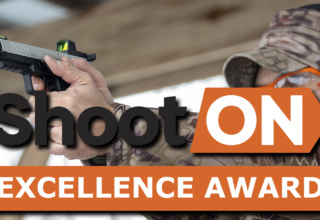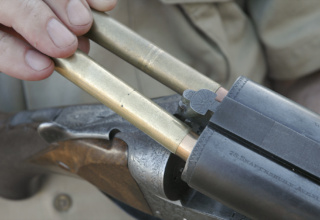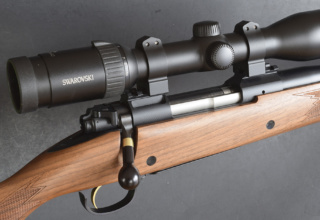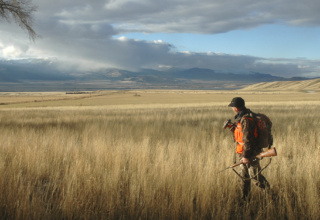Nimbler in hand than its parent, the new rifle still drilled tiny knots. But how would this dog hunt?
by Wayne van Zwoll
His shot came at 120 yards. “It was an easy poke, but I was gulping air!” The bullet shattered the elk’s spine. “A six-point! Wow! So much more than I’d imagined for a first elk!” His boyish enthusiasm belied the age and career of my friend. Hans Traska was 34 and a firearm engineer for Sturm, Ruger.
We’d met in Denver and shared a ride with Ruger’s Paul Pluff and a couple of other hunters north into Colorado’s high plateau just shy of the Wyoming line. Spur Outfitters runs a camp there. None of us had rifles. “Dave’s got ’em,” our guides assured us as we hauled duffels to our bunks. The sun got red as it closed on the horizon. Our hunt started tomorrow.
Dave’s pickup arrived, with rifles, as the sun kissed the mountains. Each of us scrambled to adopt one and prep it for a zero check.

They were identical, Paul told us — all Hawkeye Long-Range Hunters. The Hawkeye has replaced the Model 77 as Ruger’s flagship centerfire series. Like the Scout Rifle, the Hawkeye series (10 models at this writing) is based on the latest 77 action, which handles cartridges from the .204 to .416 Ruger. Now, only rimfire bolt rifles and those in .357 and .44 Magnum answer to “77-Series.”

As the Hawkeye stable evolved, I was especially keen on the Standard and African versions, with their trim checkered walnut stocks. The Hunter has replaced the Standard rifle; it is mainly a new moniker. Ruger’s Hawkeye Alaskan features a Hogue synthetic stock. The FTW Hunter — a nod to the Texas ranch that trains hunters in field marksmanship and has served as proving ground for Ruger rifles — has a camo-dipped hardwood stock. The Guide Gun and Predator wear laminated wood. You can get the Hawkeye Compact in laminate or walnut. The Long-Range Target and new Long-Range Hunter feature laminated stocks too, but they are painted “speckled black/brown.”
All Hawkeye rifles, stainless and chrome-moly, boast a non-rotating Mauser extractor and fixed ejector. Unlike early Model 77s, feeding is truly controlled from follower to chamber. The one-piece bolt is stainless, under a three-position wing safety. Barrels are cold-hammer-forged. Internal staggered-stack magazines with hinged floorplates are standard, save on the Long-Range duo, which have detachable A1-style boxes. The Target in .204, 6.5 Creedmoor, and .308, comes with a 10-shot box, in .300 Winchester Magnum with a five-shot, and in 6.5 PRC with a three-shot. The Long-Range Hunter magazine holds five in 6.5 Creedmoor and three in 6.5 PRC.

A “long-range” label brings to mind heavy barrels and bulbous stocks. So, I was surprised, tearing fingernails to unpack the new rifle, to see a barrel slim enough that the muzzle was bumped up slightly to accommodate the 5/8-24 threads securing the radial-ported brake. I promptly took a wrench to the brake and replaced it with the supplied cap. Two front swivel studs handily accommodate both sling and bipod.
While the rest of the camp held to Harris bipods, I installed only my Brownells Latigo sling.

The straight-combed stock carries no needless bulk. Three spacers allow length adjustment from 12 ¾ to 14 ¼ inches. A Picatinny rail atop the receiver adds 20 minutes of gain (up-slope to the rear) so long zeros won’t pull scope dials to extremes. Paul conceded my point that for most hunting with most scopes, this rail is useless. I needed a comb-pad to bring my eye to that high sight line. Mercifully, the receiver is machined for standard Ruger rings. Cruelly, the 8-40 Pic rail screws were as tight as welded.

Our rifles were bored to 6.5 PRC (Precision Rifle Cartridge), with 1-in-8 rifling. Based on the .300 Ruger Compact Magnum and designed to send long bullets from short actions, this efficient round has the .532 head of common magnums. Its 30-degree shoulder is set farther back than the 35-degree of WSMs, so the neck won’t over-run the shanks of missiles with Pinocchio noses. A 6.5 PRC bullet clears the muzzle roughly 250 fps faster than the 6.5 Creedmoor’s. Hornady lists its 143-grain ELD-X from the Creedmoor at 2,700 fps. The PRC kicks it at 2,960. Distance shrinks that gap, as faster bullets battle more drag. But at 500 yards, the 6.5 PRC is still 225 fps ahead, at about 2,250 fps. The 6.5/284 can match PRC velocities but begs a longer action. Ditto Hornady’s 145-grain ELD-X load in the 95-year-old .270!

The fading light and a queue behind the bench put me behind the rifle in the sage, prone. I dialed the VX-3i 4.5-14x Leupold for a 200-yard zero. As night settled in, my final three ELD-X bullets landed just over center in a 3-inch cluster at 200. The trigger, a tad stiff, broke cleanly after modest but consistent take-up. Feeding, extraction, and ejection were fault-free.
Hans took the first elk of the week. Two more would fall to the new Ruger, a shot apiece. The 6.5 PRC also downed two pronghorn bucks. Paul had a mule deer tag.

Annually, Dave and his crew bring enormous Wyoming bucks to bag. He manages 70,000 acres in Colorado. That state’s Ranching for Wildlife program gives him access to much of the land shadowed by the Never Summer and Zirkel Ranges. Paul was in good hands, in a good place.

“He was there,” muttered Dave, binocular aimed mid-slope on a tall, distant ridge. The sun was easing out of bed behind us. Our last morning. Yesterday, Paul had crawled within range of a superb buck, then waited two hours for a shot. But the deer spun as it rose and melted away.

“Look!” Paul and I aligned our glass with Dave’s toward a white speck in the brightening sage. “Antlers heavy on top…it’s him!” While we watched, the buck eased up-slope…and vanished! “Good grief!” Dave shook his head. “He’s bedded already!”

As he’d gone from our sight, so we stayed from his. We snaked up the ridge, creeping within 150 yards of bushes that had hid him before. This time Paul gave him no time to spin. A “thwuck!” followed the Hawkeye’s blast. “You don’t have to use it at long range,” deadpanned Paul.

The Ruger Hawkeye Long-Range Hunter retails for $1,279.















